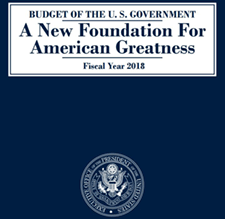 Before diving into the more interesting numbers contained within President Trump’s first official budget proposal, let’s ask a budget history trivia question: When was the last time that any US President proposed a budget for the US government that would be balanced at any time within the next 10 years of it being proposed?
Before diving into the more interesting numbers contained within President Trump’s first official budget proposal, let’s ask a budget history trivia question: When was the last time that any US President proposed a budget for the US government that would be balanced at any time within the next 10 years of it being proposed?
If you guessed President George W. Bush in 2007, you’re right!
Now, if you were to ask when the last time that a US President proposed and delivered a balanced budget, you would have to go back to the turn of the century in 2000, where President William J. Clinton’s final budget proposal for the federal government’s 2001 fiscal year produced a budget surplus.
It’s important to consider these two dates because it has been nearly 10 years since a US President even proposed a budget that would reduce the government’s annual spending deficit to zero within a ten year period, and it has been four whole presidential terms since a US President’s budget delivered a surplus to the US Treasury.
Read Are You a "Trump Alarmist"?
That makes zero the most interesting and important number in President Trump’s first budget. Sure, he gets there through the same kind of questionable accounting and optimistic assumptions that characterizes virtually all budget proposals produced in Washington D.C., but when you consider that President Obama’s 2017 budget was projected to leave the US government over .4 trillion more in the hole after 10 years, with ever escalating budget deficits setting in after 2018, President Trump’s first budget proposal represents a notable step toward reversing what would otherwise be the US government’s deteriorating fiscal condition, even with its apparent deficiencies.
The next most interesting number in President Trump’s first budget is 66. That is the number of federal government programs that the President has targeted to be eliminated. While getting rid of these programs would reduce the annual spending of the US government by just .7 billion out of an annual budget of more than trillion, these are exactly the kind of programs that should be eliminated because what they do is either unnecessary or is duplicated more effectively by other federal spending programs. That they have persisted so long after their useful contributions to the American people have diminished is attributable to Washington D.C.’s power games, where they have largely become vehicles for channeling money to the parochial pet interests and campaign contributors of the US politicians who champion them to demonstrate their power and influence.
The third number of interest in President Trump’s first budget proposal is .7 trillion. That is the amount by which the US government’s total spending will have increased above 2017’s projected spending level of .1 trillion to reach its projected level of .7 trillion in 2027. To get there, the US government’s spending will increase at an average rate of 3.5% per year over the next decade.
To put that number into historical context, in the ten preceding years from 2007 to 2017, the US government’s spending increased from .7 trillion to .1 trillion, which works out to be an average 4.1% annual rate of increase. President Trump’s proposed pace for increasing federal government spending is just 0.6% slower than that!
You may also like Republican Tax Reform May Accelerate Exodus Out of California
Now, if you want to understand why so many politicians and political pundits are howling about President Trump’s budget “cuts”, President Barack Obama’s final budget proposal would have had the US government’s spending increase from .0 trillion in 2016 to .5 trillion in 2026 at an average annual rate of increase of 5.0%, an unsustainable acceleration of spending growth that the Congressional Budget Office was already projecting would cause the US government’s fiscal situation to significantly worsen.
Apparently, a lot of politicians and political pundits either don’t think that’s much of a problem or don’t believe that they would be on the hook for causing that problem. But that’s typical Washington D.C. thinking for you.
By Craig Eyermann
Read next: Should We Pay Off $20 Trillion in National Debt by Selling Federal Assets?





